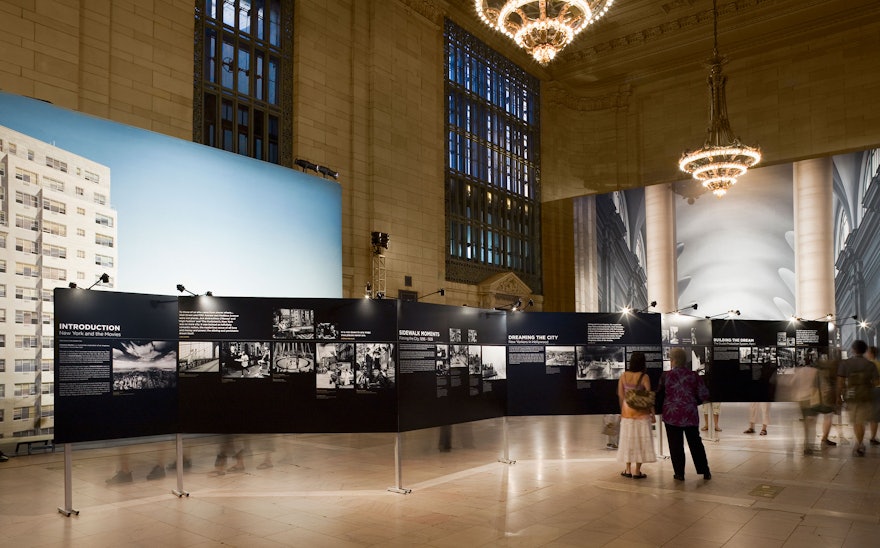Pentagram, in collaboration with the author and architect James Sanders, has designed the exhibition Celluloid Skyline: New York and the Movies that opens today in Grand Central Terminal. The month-long multimedia exhibition, based on Sanders’ classic book by the same name, relates the hundred-year plus history of filmmaking in and about New York City in a display of original scenic backings, film footage, production stills, and exhibition panels complete with quotes, location shots, art department drawings and renderings.
Celluloid Skyline was designed to create an environment that recalls the cinematic experience, and the exhibition takes full advantage of Vanderbilt Hall’s dramatic interior, a space itself so representative of New York and one of the few rooms in the city large enough to hold the exhibition’s contents. “This is not a conventional museum-style exhibit, but rather a vast, immersive, magical environment that allows people to walk into the ‘movie New York’ of their dreams,” says Sanders.
The highlights of the exhibition are the four gigantic “scenic backing” paintings used in such films as Alfred Hitchcock’s North by Northwest and Vincente Minnelli’s The Clock. These meticulously rendered cityscapes, some more than 25 feet high and 60 feet long, have never been publicly exhibited and are hung on scaffolding around the perimeter of the room. The result is a space in which visitors feel, in Sanders’ words, “as if they are actually inhabiting the various environments of the filmic city—streets, skyscrapers, rooftops, theaters, waterfronts, interiors—allowing viewers to come away with a greater understanding not only of the moviemaking process, but of the urban character, texture and significance of the real city.”
While the unprecedented gathering of backdrops, stills and film clips draw visitors into the exhibition, large display panels guide visitors through the space as they recount the history of New York filmmaking from the late nineteenth century to the present day. The five-foot tall panels were conceived to be comprehended individually, as well as collectively, in response to the unique audience the exhibition will draw: the 700,000 people who pass through Grand Central everyday and those who have come to Grand Central specifically to see Celluloid Skyline.
The panels are connected accordion style and with their black background and white type, they snake their way through Vanderbilt Hall like a piece of film unspooled from its reel. While this aspect of the panels’ design references “movie New York,” the skyline of the “real” New York is evoked as well. The exhibition also features film footage from Paramount Studios from the mid-1930s to today digitally projected on three large rear-projection screens; fifty “actuality” films—short silent films of New York street life from the late nineteenth and early twentieth century—continuously projected on a 60-inch plasma monitor; and dramatic enlargements of more than 160 rare and unusual production stills.

